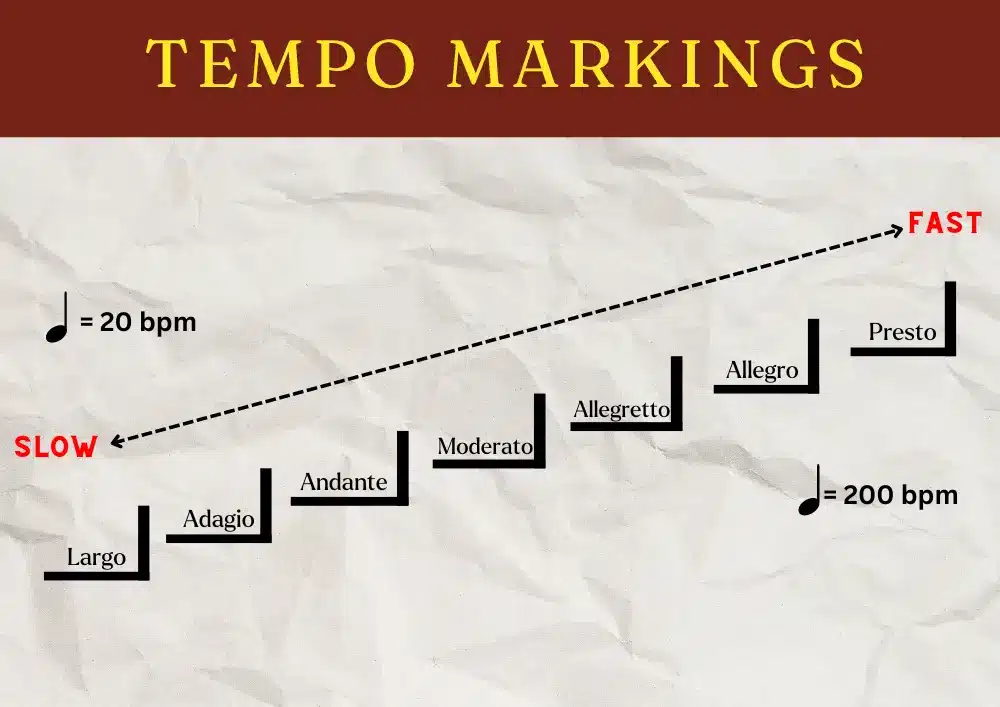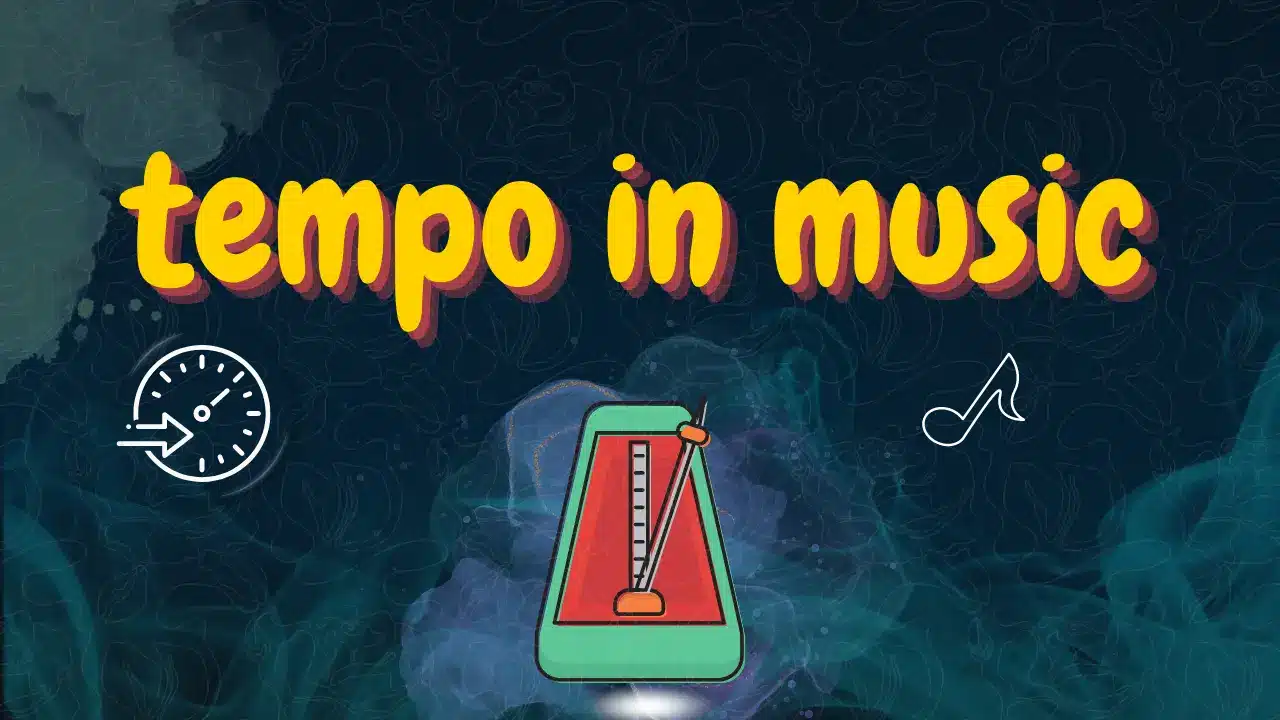- What is Tempo in Music?
- Tempo in Music- in the early days
- What are the Tempo Markings?
- Common Tempo Markings in Music
- Additional Tempo terms frequently added to the above list of Tempo Markings
- Importance of Tempo in Music
- Famous songs with specific Tempos
- Staying Alive by Bee Gees
- Shape of You by Ed Sheeran
- Happy by Pharrel Williams
- Good 4 U by Olivia Rodrigo
- Easy On Me by Adele
- Closing Thoughts
- FAQs
Here’s a juicy fact about Tempo’ meaning. It actually controls the emotional perception of a piece of music that you hear! Like is said, juicy! It’s a fairly simple yet very important concept in music.
Tempo in music is key to determining the mood of a piece of music. It provides a structural and a rhythmic framework that guides the performers to engage the listeners.
We’re gonna look into “What is Tempo?”, “What are Tempo Markings” and how to use them.
What is Tempo in Music?
Well, the speed in which you sing or play a musical piece is called the Tempo. The word Tempo comes from the Latin word “Tempus” . Tempus means Time. Tempo in music is considered as one of the most fundamental and essential concepts. As mentioned earlier, music- Tempo has a major influence on the overall mood of a piece. It lays down the rhythmic framework required to engage the listeners. Learners and professionals use a device called Metronome to measure and follow music tempo.
Commonly, learners mistake tempo and rhythm the same. Let me assure you, it most certainly is not!. Simplest definition of rhythm in music is “it is an arrangement of sounds and silences in a pattern.”
Looking into, What is Tempo in music ? Tempo is the speed of written Music. Rhythm is a pattern of notes.

Did You Know?
Metronome was invented by Johann Nepomuk in the year 1815
Tempo in Music- in the early days
In the early days, music was generally oral and did not have written format. Cultural ceremonies, traditional worshiping etc, had the influences of music. There were no proper specifications of music-tempo in the Ancient times.
- Around 9th Century
Moving on to the medieval times, music started getting written down using symbols and words and slowly began using the concept of “tempo”. Terms like “tempus” started to appear on sheet music. - 15- 19th Centuries
Renaissance had somewhat clear instructions on Tempo music sheets. Composers like Josquin, Pierluigi used tempo markings in their compositions. - Composers like Bach, Handel used it more precisely using Italian terms like Adagio, Presto or Allegro during the Baroque Period.
- 18-19 Centuries
More precise tempo markings in music using Italian terms along with numerical in the form of beats per minute was introduced in 1815. Mozart, Beethoven had exact tempo guidance in their compositions during the Classical Era. - Romantic composers like Chopin, Mahler used expressive range of tempo markings using terms like “rubato.”
- Post 20th Century
The 20th Century had more diverse use of tempo markings in music. It had vast changes when composers like Stravinsky or Schoenburg started experimenting. Usage of Syncopations and more improvisations on the conventional music-tempo started surg facing in Jazz.
What are the Tempo Markings?
Those are simply the words referring to the tempo terms. These are commonly used indications to direct the performers about the speed of a musical piece. Tempo markings in music are written in Italian, that help the performers interpret the mood, rhythms and feel of the music.
This is to signify the historical development of Classical Music in and around Europe. Each Italian tempo marking has a different meaning and interpretations, those are followed by the Numerical value of the music tempo in the form of Beats Per Minute (BPM). Let’s look at the types of tempo markings.

Common Tempo Markings in Music
- Grave
The term Grave indicates a very slow or a solemn tempo. It is the slowest tempo marking and denotes that the piece of music must be played extremely slowly. Its tempo ranges between 2-40 BPM. - Adagio
Adagio tempo meaning slowly or leisurely. The exact tempo can vary based on the composer’s requirement and generally falls between 60-80 BPM.? - Andante
Andante means to play or sing at a walking pace. It is slightly faster than adagio. It’s usually used for tempo from 75-108 BPM. - Moderato
Moderato simply means Moderately. This tempo marking in music is used to indicate that a piece of music to be sung or played at a moderate pace from 108- 120 BPM. It is neither fast nor slow. - Allegerato
Allegretto indicates a tempo that is moderately fast. Allegerato is faster than andante yet slower than allegro. It ranges from 112-120 BPM - Allegro
Allegro is a tempo marking used to show a tempo that is fast and lively. It typically ranges from 120-168 Beats Per Minute. - Vivace
Vivace, another tempo marking used to specify lively tempo that is faster than Allegro on a musical sheet. Composers use vivace to establish a vigor or an energetic mood. Its tempo ranges between 168 and 176 BPM. - Presto
This conveys a very fast tempo ranging from 168 to 182 BPM. - Prestissimo
Prestissimo is used to indicate an extremely fast music tempo. 200 Beats Per Minute and above is its numerical value.

Did You Know?
Tempo markings were standardized by music composers like Vivaldi and Bach.
Additional Tempo terms frequently added to the above list of Tempo Markings
- Poco
Little or Slightly. This is added as a prefix to direct the performer to make gradual changes.
For example: ‘Molto Adagio’ indicates the performers to perform ‘much’ slowly - Ritardando
Abruptly slowing down (rit ..) ‘rit.’ means to gradually slow down the tempo in music. One common question: What is the tempo of Ritardando? Well, there are no exact values. It entirely depends on the performer. - Rallentando
Slowing down gradually(riten.) It means to gradually slow down the music tempo. - Accelerando
Speeding up (accel.) ‘accel.’ means to gradually slow down the music tempo. - Subito
Suddenly or Immediately. Subito is mentioned when the composer wants sudden or abrupt changes in a tempo.
For Example: sub. Accel would mean sudden increase in tempo - Piu
More. Piw is usually used to increase the intensity of a tempo.
For example: piu allegro – more lively. - Con Moto
With motion. Con Moto instructs performers to make perform in a tempo with motion or movement, - Rubato
Flexible Tempo. Rubato suggests playing or singing subtly, speeding and slowing down the music tempo according to the pace of the piece of music. - A Piacere
At Pleasure. ‘A Piacere’ lets performers choose a tempo that feels more natural and expressive to them.
Importance of Tempo in Music
Since tempo is upon which other elements like melody, harmonies, rhythms are built, it is very essential to have a good grip on. Imagine singing about a heartbreak in a vivace! Imagine playing an enthusiastic melody in Adagio. Would the right emotion or mood be conveyed?
And so this is essential to factor in the right interpretation of a musical piece and connecting with audiences. Secondly, it’s most important for synchronization of different instruments including voice in an ensemble. Be it fast tempo or slow tempo songs, a technical tool is required to keep all the elements in a song to keep on track.
Tempo in music helps you understand and identify the genres of music on some level. Lastly, composers uses it like a language to show shifts in mood or expressions, emotional or the narrative depth.
Famous songs with specific Tempos
Here are some famous songs with specific tempos for your understanding.
Staying Alive by Bee Gees
This is a disco song with a Tempo of 104 BPM, Mode, Moderato. The Tempo meaning in this song is moderate.
Shape of You by Ed Sheeran
‘Shape of you’ is relatively a slow song with a tempo of 96 BPM.
Happy by Pharrel Williams
‘Happy’ is a fast and upbeat song. It is one of the Famous songs with a specific tempo of 160 BPM.
Good 4 U by Olivia Rodrigo
An energetic, punk-rock song in Vivace. Now, Vivace tempo meaning, fast and upbeat in 170 BPM.
Easy On Me by Adele
A heartfelt ballad in a slow tempo at 67 BPM.
Closing Thoughts
Tempo in music sets the pace of a music piece. All the Italian tempo markings give you guidance on how to play or sing with correct interpretations. It’s not just about the speed but a basic element that shapes up an entire structure of a piece of music. In music classes, we explain ‘What is tempo in music’ and demonstrate it clearly. To learn such concepts in depth and at ease, book a free western music class demo with us today!
FAQs
What is tempo in music?
This refers to the speed in which a piece of music is sung or played.
How to determine the tempo of a song?
You can always look for the directions or the indications mentioned on a music sheet.
What are the different types of tempo in music?
The different types of tempo in music includes Presto, vivace, moderato, allegro, allegretto,andante, adagio, grave.
Why is tempo important in music?
Other elements of music like melody, harmonies, rhythm etc. are shaped up by the tempo.
How does tempo affect music?
Tempo can have an impact on the emotion, structure of other musical components if not determined properly.
What are common tempo markings in music?
Comom tempo markings include adagio, andante, moderato, allegretto, ritenendo, subito etc.
What is the difference between tempo and rhythm?
Tempo is the speed at which a piece of music is played or sung while rhythm is a pattern of beats in tempo.
How to measure tempo in music?
Tempo is measured in Beats Per Minute in music.
Related blog: Dynamics in Music




































